In the fall of 2005, I joined Cornell’s Society for the Humanities as a post- doctoral research fellow with a standard teaching commitment of a single semester of seminar teaching. My year at the Society was a productive one, exploring the theme of Culture and Conflict in lively and thoughtful seminars and participating in many Cornell events, symposiums, workshops and colloquiums including: Primitivism and Pop Culture, (Lecture) Telluride House, October 2005; Whose Primitivism, Whose Theory? (Lecture) The Society for the Humanities Graduate Workshop in Culture and Conflict, November 2005; Whose Primitivism, Whose Theory? (Lecture) Africana and Queer Studies Perspective Spring Colloquium, February 2006; Black Magic, (Seminar/Lecture) Society for the Humanities, February, 2006; Exoticism in Black and White (Lecture) Visual Studies Colloquium, March 2006; Strange Fruit: Lynching, Visuality and Empire, (Panel Chair) March, 2006; The One Love Workshop, Telluride House, April 2006. In addition, I gave two papers at institutions elsewhere including: Why Not America, Nancy? (Lecture) SUNY Albany, New York State, October 2005; Exoticism, (Lecture) Jungles in Paris Conference, Tate Modern (Bankside) London UK, December 2006. Over the Christmas and Spring breaks I made two significant study trips, the first partially funded by the ASRC to Luxor, Egypt and the second, funded independently, to Addis Ababa, Ethiopia.
I believe the research begun in these places and the connections I have established will serve well for future academic and exhibition work. Already, I have spearheaded the team that organised a symposium on Ethiopia titled Ethiopia: Monarchy and Modernity that took place at the Johnson Museum and the ASRC in 2007. It is intended that the symposium will generate research for a publication Ethiopia: Monarchy and Modernity, currently under review by the German publishers Prestel and an exhibition with the same name
After an active and successful year of research, teaching and lecturing, I was invited to stay on as a Visiting Associate Professor teaching courses cross-listed between the departments of History of Art, ASRC and Visual Studiesas well as piloting programs for online learning for Cornell's Summer and Winter Sessions
Past experiences: Teaching
My past teaching experience has been varied and centered in a number of institutions in the Caribbean and Britain where I received my masters and doctorate degrees. Before leaving Jamaica, I taught courses in Critical Analysis and Contemporary Jamaican Art at Jamaica School of Art then transferred the same skills to Britain. There, I taught initially at Brixton College, London and latterly at Cheltenham Art College where over a period of five years 1988-1993, I taught Critical Studies.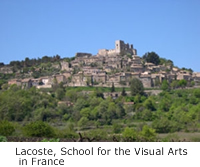 While completing graduate studies in France, I taught Modern Art History: From Impressionism to Abstraction at the Lacoste Institute's School For the Arts in France (1991) in Lacoste a small village 40 miles south of Avignon, famous for the Marquis de Sade's chateaux and for being a haven for the Surrealists during the second world war.
While completing graduate studies in France, I taught Modern Art History: From Impressionism to Abstraction at the Lacoste Institute's School For the Arts in France (1991) in Lacoste a small village 40 miles south of Avignon, famous for the Marquis de Sade's chateaux and for being a haven for the Surrealists during the second world war.
On completion of my doctoral studies program at the Courtauld Institute, University of London in 1994, I stayed on to teach two courses Ideas of the Primitive and Going Native. Although teaching has played a significant role in my professional career, since gaining my Ph.D. in 1994, the focus of my work has been on consultancy and curatorial projects and I have worked for a number of agencies, galleries and museums as an independent consultant. My first significant assignment was for the Royal Academy in 1995, where I was the co-ordinating editor for the ground-breaking exhibition and publication Africa the Art of a Continent. Returning to Jamaica, I was then appointed to the National Gallery of Jamaica as a visiting curator and later, member of the Board of Directors, a position I have held since 2000. Concurrently, having completed a number of curatorial projects for the British Council, I was approached by them to conduct an evaluation of their programs in the Caribbean (1999-2000). This involved extensive travel throughout to the region's English, French and Spanish speaking islands, familiarizing myself with the major arts institutions, artists, cultural agencies and diplomatic missions in order to foster future collaborations.
Past Experiences: Curatorial Consultancies
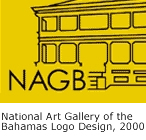 In 2001, as a result of my Caribbean work, and on the completion of my British Council projects, I was invited by the National Art Gallery of the Bahamas to spearhead their formation, development and promotion related to the establishment of a new gallery in the heritage building, Villa Doyle. Appointed as director/consultant curator for the next three years, I guided that institution on matters regarding its building development, curatorial and policy development, training, staffing, vision and mission statement until its opening in June 2003.
In 2001, as a result of my Caribbean work, and on the completion of my British Council projects, I was invited by the National Art Gallery of the Bahamas to spearhead their formation, development and promotion related to the establishment of a new gallery in the heritage building, Villa Doyle. Appointed as director/consultant curator for the next three years, I guided that institution on matters regarding its building development, curatorial and policy development, training, staffing, vision and mission statement until its opening in June 2003.
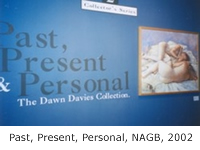 Throughout, I maintained my professional activities as a curator, in the main, making exhibitions that exposed international audiences to British and Caribbean art. My Caribbean exhibitions include; One Man’s Vision: The Vincent D’Aguilar Collection (NAGB, 2003) and Past, Present and Personal: The Dawn Davies Collection (NAGB, 2004), Fifty Years - Fifty Artists ( EMCVPA, 2003). My international exhibitions include Home and Away: Seven Jamaican Artists, October Gallery (London 1994): New World Imagery: Contemporary Jamaican Art (South Bank Centre - National Touring Exhibitions, 1995), Photos and Phantasms: Harry Johnston’s Photographs of the Caribbean (Royal Geographical Society, London and touring, The British Council, 1998) and Back to Black, (Whitechapel Gallery, London 2005).
Throughout, I maintained my professional activities as a curator, in the main, making exhibitions that exposed international audiences to British and Caribbean art. My Caribbean exhibitions include; One Man’s Vision: The Vincent D’Aguilar Collection (NAGB, 2003) and Past, Present and Personal: The Dawn Davies Collection (NAGB, 2004), Fifty Years - Fifty Artists ( EMCVPA, 2003). My international exhibitions include Home and Away: Seven Jamaican Artists, October Gallery (London 1994): New World Imagery: Contemporary Jamaican Art (South Bank Centre - National Touring Exhibitions, 1995), Photos and Phantasms: Harry Johnston’s Photographs of the Caribbean (Royal Geographical Society, London and touring, The British Council, 1998) and Back to Black, (Whitechapel Gallery, London 2005).
Past Experiences: Publications
As a writer, and being conscious of the paucity of art historical material in the Caribbean, I have been careful to choose projects that allow for extensive cataloging. As a result, most of my curatorial and art historical projects have been documented. My most significant publications include Jamaican Art (Kingston Publishers, 1990), Fifty Years-Fifty Artists (Ian Randle Publishers, 2000), and Negrophilia: Avant Garde Paris and Black Culture in the 1920s (Thames & Hudson, 2000) and Back to Black, 2005, co-authored with Richard Powell and David Bailey. I have also written numerous articles on a wide range of issues related to my research in the field of Negrophilia including; A Double Edged Infatuation, The Guardian, London, 2000 Paradise, Primitivism and , Parody in Okwui Enwezor~Carlos Basualdo~Ute M. Bauer, Creolite and Creolization, Documenta 11- Platform 3, Kassel, 2002; Why Not Africa, Nancy? Norman Douglas, (3rd Symposium) Thuringen, Austria, 2003. Since 2000, I have focused my critical writing around the work of a handful of female artists, these articles have all been published by Caribbean Beat, MEP, Trinidad, 2000-2003 and include “Hope Brooks: Hope in a Town House,” (1998); “Petrona Morrison: A Pilgrims Progress,” (2002), “Seya Parboosingh; Painting a Love Story,” (2002); “Cheryl Daley : Weaving a Tapestry of Life,” (2003) and “Laura Facey: Beauty and the Beast” (2004).
Past Experiences: Painting
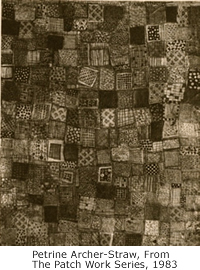 As a professional painter, my art works are known for their highly textured, patterned and 'feminized' surfaces, normally created in mixed media. I regularly exhibited in Jamaica during the 1980s and held a number of important group and solo exhibitions, including: Painting, Patchwork, Paper, The Barn, 1983, Patchwork : The Female Pattern, Frame Centre Gallery 1984, Young Talent, National Gallery of Jamaica, (1984) and Magic Carpets, Frame Centre Gallery 1986 and my paintings can be found in renowned private and public collections including the Victoria & Albert Museum, London.
As a professional painter, my art works are known for their highly textured, patterned and 'feminized' surfaces, normally created in mixed media. I regularly exhibited in Jamaica during the 1980s and held a number of important group and solo exhibitions, including: Painting, Patchwork, Paper, The Barn, 1983, Patchwork : The Female Pattern, Frame Centre Gallery 1984, Young Talent, National Gallery of Jamaica, (1984) and Magic Carpets, Frame Centre Gallery 1986 and my paintings can be found in renowned private and public collections including the Victoria & Albert Museum, London.
In addition to my artistic practice, in the 1980s and 90s, I worked as an arts critic, producing the radio program Inside the Arts and writing articles on the Jamaican cultural scene, for the Artists Eye column of The Daily Gleaner national newspaper. All are currently archived in Jamaica.
Past Experiences: Media
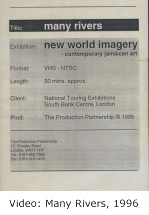 I have also produced my own documentary on contemporary Jamaican art Many Rivers, (The Production Partnership), 1995. In addition, I have made numerous international television and radio appearances including regular commentaries for the BBC World Service's Meridian Arts program and television documentaries including: Jerry Hall's Art Deco and the Art of Glamour, 2004, Lucinda Lambton's Jamaican Adventure, BBC 2005, and the The Josephine Baker Story, BBC 2006. More recently, I have developed my own web site and web logs that can be viewed at www.petrinearcher.com , www.diasporadialogs.com.jm and www.negrophilia.com.jm.
I have also produced my own documentary on contemporary Jamaican art Many Rivers, (The Production Partnership), 1995. In addition, I have made numerous international television and radio appearances including regular commentaries for the BBC World Service's Meridian Arts program and television documentaries including: Jerry Hall's Art Deco and the Art of Glamour, 2004, Lucinda Lambton's Jamaican Adventure, BBC 2005, and the The Josephine Baker Story, BBC 2006. More recently, I have developed my own web site and web logs that can be viewed at www.petrinearcher.com , www.diasporadialogs.com.jm and www.negrophilia.com.jm.
Past Experience: Education
Born in Birmingham, England, to Jamaican parents much of my art historical work centers around the specific cultural milieu of Britain and the Caribbean in the past century. I see my work as mediating between two estranged but nevertheless entangled communities. I believe my educational background has placed me perfectly for this process of negotiation. I received my childhood and teenage education in Birmingham attending primary and grammar school there. On my arrival in Jamaica as a young adult, I completed sixth form at Kingston's Ardenne High School and then went on to complete my first degree, a BA, majoring in Theology, History and Sociology at the University of the West Indies (UWI). Convinced that I wanted to become a practicing artist, I immediately enrolled at the Jamaica's School of Art where I received a Diploma with honors majoring in Painting and was the class of '82 valedictorian. While exhibiting professionally and working as an Education/Research officer at the National Gallery of Jamaica, I returned to the UWI where I completed an M.Phil in Cultural History under the guidance of professors Neville Hall, Patrick Bryan and Kamau Braithwaite. Finally, in 1987, I decided to complete an academic program in Art History at the Courtauld Institute, University of London, receiving an M.A with distinction in 1989 and my Ph.D. (Negrophilia) in 1994.
Past Experiences: Present Perspectives
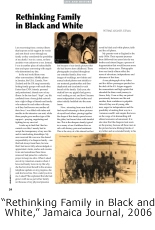 My interest in the visual culture has also been informed by my own background as a practicing artist as well as a cultural historian, this has been an important feature of the way that I approach art history. Even with my respect for the field, I am interdisciplinary in my approach, drawing on personal narrative, folklore, visual studies, cultural studies and other humanistic and social science disciplines to support my research. This has allowed me to incorporate different methodologies and theoretical approaches in my research, publications and teaching. My interest in African and African Diaspora visual arts, critical theories of contemporary art and visual culture, African and non-western theory, notions of the 'primitive', 'intuitive' and 'self taught' artists and ideas of the 'other' have always been a corollary to my thinking as a result of my background of working in the arts in the Caribbean. My perspectives were strengthened during my time at the Courtauld Institute most often in response/reaction to my formal training there and in the context of a developing discussions about post-modernism.
My interest in the visual culture has also been informed by my own background as a practicing artist as well as a cultural historian, this has been an important feature of the way that I approach art history. Even with my respect for the field, I am interdisciplinary in my approach, drawing on personal narrative, folklore, visual studies, cultural studies and other humanistic and social science disciplines to support my research. This has allowed me to incorporate different methodologies and theoretical approaches in my research, publications and teaching. My interest in African and African Diaspora visual arts, critical theories of contemporary art and visual culture, African and non-western theory, notions of the 'primitive', 'intuitive' and 'self taught' artists and ideas of the 'other' have always been a corollary to my thinking as a result of my background of working in the arts in the Caribbean. My perspectives were strengthened during my time at the Courtauld Institute most often in response/reaction to my formal training there and in the context of a developing discussions about post-modernism.
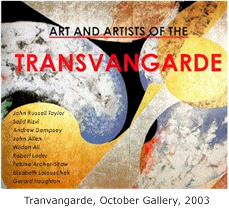 While completing graduate studies, I began working on extra curricula projects that enabled me to explore current debates around race, and popular culture. Eventually, this had its impact on my thesis research as well as my independent curatorial work. In 1994, working on exhibition and education programming I eventually became a visiting curator for the 'transvangarde' October Gallery, Bloomsbury London (1998). This trend has followed me through my curatorial career, and has had a defining impact on my research interests and teaching that increasingly tend towards cultural or diaspora studies using web technology.
While completing graduate studies, I began working on extra curricula projects that enabled me to explore current debates around race, and popular culture. Eventually, this had its impact on my thesis research as well as my independent curatorial work. In 1994, working on exhibition and education programming I eventually became a visiting curator for the 'transvangarde' October Gallery, Bloomsbury London (1998). This trend has followed me through my curatorial career, and has had a defining impact on my research interests and teaching that increasingly tend towards cultural or diaspora studies using web technology.